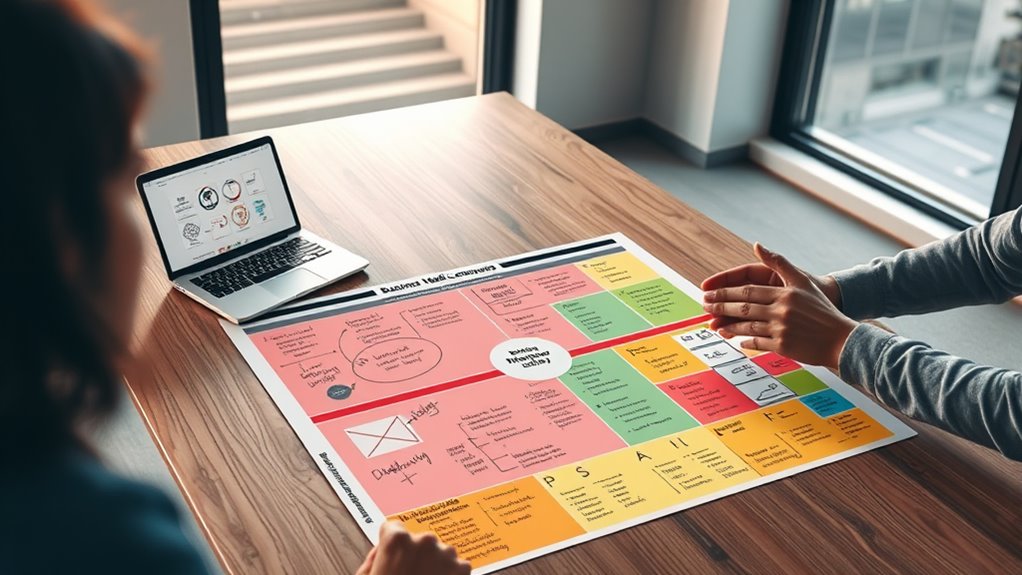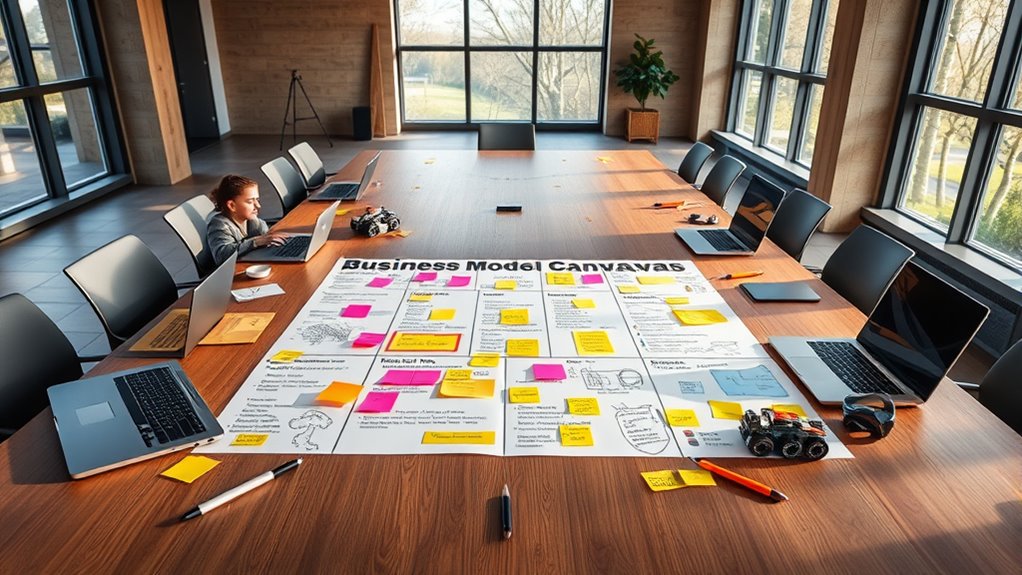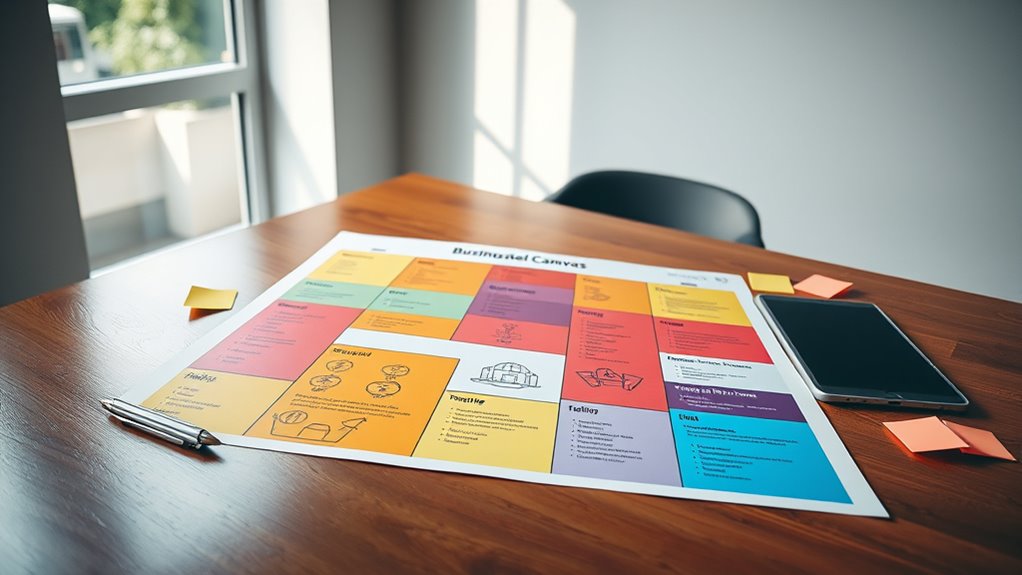A Business Model Canvas: Design Thinking Edition helps you put customer needs at the core of your strategy. It combines visual storytelling with empathy-driven insights to inspire innovative ideas, rapid prototyping, and continuous feedback. By integrating human-centered approaches, you can refine your value propositions, align resources, and create sustainable, adaptable models. If you keep exploring, you’ll discover how to build a more customer-focused and resilient business that evolves with market changes.
Key Takeaways
- Integrates empathy mapping and customer journey insights to foster human-centered, emotionally intelligent value propositions.
- Emphasizes stakeholder engagement and open brainstorming to drive innovative, flexible business models.
- Incorporates rapid prototyping and iterative feedback loops for continuous testing and refinement of core components.
- Aligns resources and activities directly with customer needs, enhancing authenticity and market relevance.
- Uses visual storytelling and AI-driven insights to identify gaps, opportunities, and ensure sustainable growth.
Understanding the Core of Design Thinking in Business Modeling

Have you ever wondered how businesses innovate and stay ahead in competitive markets? It all starts with understanding the core of design thinking, which emphasizes creative brainstorming and stakeholder engagement. By encouraging open, collaborative ideas, you can uncover innovative solutions that truly meet customer needs. Engaging stakeholders early in the process helps you gather diverse perspectives, fostering empathy and ensuring your business model aligns with real-world demands. This iterative approach pushes you to test assumptions quickly and refine ideas continuously. When you focus on these elements within your business modeling, you create a foundation that’s flexible, customer-centric, and primed for innovation. Incorporating essential essential oils can even inspire creative thinking and clarity in decision-making. Ultimately, embracing this core makes your strategies more adaptable, competitive, and aligned with evolving market trends.
The Traditional Business Model Canvas: A Brief Overview

The traditional Business Model Canvas highlights core components that define how your business creates value. It serves as a visual strategy tool, helping you see the relationships between different elements clearly. By understanding these parts, you can better craft and refine your overall business approach. Incorporating insights from Crypto Market Trends can also provide valuable context for adapting your business model in a rapidly evolving landscape.
Core Components Overview
What makes the Business Model Canvas an effective tool for designing and analyzing your business? It provides a clear view of its core components, helping you understand how everything connects. You’ll examine the customer journey to identify touchpoints where you add value and build relationships. The canvas also highlights your revenue streams, showing how your business earns income from each customer segment. By visualizing these elements side-by-side, you can spot gaps, overlaps, and opportunities for innovation. This straightforward approach enables you to quickly test ideas, make adjustments, and develop a sustainable model. Ultimately, the core components work together to give you a holistic map of your business, guiding strategic decisions and fostering growth. Incorporating AI-powered tools can further enhance your analysis and decision-making capabilities by providing data-driven insights.
Visual Strategy Tool
Ever wonder how a simple visual tool can clarify complex business strategies? The Business Model Canvas serves as that powerful visual strategy tool. It uses color theory to differentiate sections, making it easier to grasp key components at a glance. By applying storytelling techniques, you can craft a narrative that highlights how each part connects, emphasizing the flow from value proposition to customer relationships. This visual approach transforms abstract ideas into tangible visuals, helping you identify gaps and opportunities quickly. The layout encourages active engagement, making it easier to communicate your strategy to stakeholders. Additionally, understanding different electric bike options and their costs can inform strategic decisions when expanding product lines. Overall, the traditional Business Model Canvas simplifies complexity through visual storytelling, ensuring your business model is clear, memorable, and actionable.
Integrating Empathy to Identify Customer Needs

How can you truly understand your customers’ needs? The key is integrating empathy into your process. Start with empathy mapping to visualize what customers think, feel, say, and do. This helps you grasp their emotions and motivations. Additionally, examine the customer journey to identify pain points and moments of delight along their experience. By stepping into their shoes, you uncover insights that might otherwise go unnoticed. This deep understanding guides your decisions, ensuring your value propositions and solutions resonate. Remember, empathy isn’t just about listening—it’s about actively engaging and reflecting on their perspective. When you prioritize empathy, you create a more accurate picture of customer needs, laying a solid foundation for developing solutions that truly meet their expectations. Incorporating user personas can further refine your understanding by representing key segments of your audience.
Ideation and Prototyping: Fostering Innovative Solutions

Have you ever wondered how to turn customer insights into innovative solutions? The key is effective ideation and prototyping. Start with brainstorming techniques like mind mapping or SCAMPER to generate diverse ideas quickly. Focus on quantity over quality initially—this encourages creativity without self-censorship. Once you have several concepts, move to idea validation by evaluating feasibility and potential impact. Rapid prototyping allows you to turn ideas into tangible models, helping you visualize solutions and identify flaws early. This iterative process fosters innovation by combining creative thinking with practical testing. Remember, the goal isn’t to find perfect solutions immediately but to explore possibilities and refine them through continuous feedback. Incorporating design principles ensures your solutions are both innovative and aligned with customer needs.
Iterative Testing and Feedback Loops for Continuous Improvement

Iterative testing and feedback loops are essential for refining your business model and ensuring continuous improvement. By actively seeking customer feedback, you gain valuable insights into how your offerings resonate and where adjustments are needed. This process allows you to make iterative refinements, testing assumptions, and validating ideas quickly. As you gather feedback, you can identify pain points, validate value propositions, and optimize your business model more effectively. Regularly cycling through testing and feedback helps you stay aligned with customer needs and market trends. Embracing this iterative approach means you’re continuously learning and evolving, making smarter decisions based on real data rather than assumptions. Incorporating tools like the Pimple Patch can serve as an example of effective targeted treatment that improves overall product offerings. This ongoing process ultimately leads to a more resilient, customer-centric business model.
Reimagining Value Propositions With a Human-Centered Approach

What if reimagining your value propositions centered on human needs could transform your business? By applying emotional intelligence, you can better understand your customers’ desires, fears, and motivations. Cultivating cultural sensitivity helps you respect diverse backgrounds and tailor offerings accordingly. This human-centered approach shifts your focus from simply selling products to genuinely meeting needs, creating stronger emotional connections. Instead of assumptions, listen actively to customer feedback and observe their behaviors. This insight allows you to craft value propositions that resonate deeply, fostering loyalty. Remember, a thoughtful understanding of human experiences enhances innovation and differentiates your brand. When you prioritize empathy and cultural awareness, your value propositions become more authentic, impactful, and aligned with what your customers truly want and value. Additionally, incorporating music therapy principles can enhance customer engagement by addressing emotional and sensory needs, making your offerings even more meaningful.
Aligning Key Resources and Activities With Customer Insights

To succeed, you need to align your key resources and activities directly with customer insights, ensuring every effort addresses their needs. Implement resource optimization strategies that maximize value without waste, and focus your activities on what truly resonates with your audience. When your paint sprayer technology stays central, your operations become more focused and impactful.
Resource Optimization Strategies
Have you ever wondered how aligning your key resources and activities with customer insights can boost your business’s efficiency? Resource optimization strategies focus on ensuring your resource allocation directly supports what your customers value most. By understanding customer needs, you can prioritize investments in areas that deliver the highest impact, avoiding waste. Efficiently allocating resources means focusing on the right people, technology, and processes to meet customer demands effectively. This alignment minimizes unnecessary costs and maximizes value delivery. Implementing efficiency strategies helps you streamline operations, reduce redundancies, and focus on high-impact activities. Additionally, considering specialized segments such as Mother Baby Kids can further refine resource allocation to target specific customer groups. Ultimately, optimizing your resources based on customer insights creates a more agile, responsive business, enabling you to adapt quickly and sustain competitive advantage.
Activity-Centric Insights Alignment
Ever wondered how aligning your key resources and activities directly with customer insights can drive better business outcomes? When you prioritize this alignment, you enhance user engagement by tailoring your operations to meet customer needs more effectively. This focus guarantees your resources support activities that resonate with your audience, fostering stronger connections. Additionally, aligning activities with insights helps maintain branding consistency, reinforcing your brand’s values and message across all touchpoints. By doing so, you create a cohesive experience that builds trust and loyalty. This strategic approach allows you to optimize resource utilization, reduce waste, and deliver value more efficiently. Ultimately, it creates a business framework where your operations directly respond to what customers truly want, boosting satisfaction and long-term success.
Value Proposition Focus
Aligning your key resources and activities with customer insights sharpens your value proposition, making it more relevant and compelling. By integrating emotional branding and storytelling techniques, you create a deeper connection that resonates with your audience’s values and aspirations. Focus on what truly matters to your customers, and tailor your resources to amplify these emotional triggers. This alignment ensures your offerings evoke authentic feelings, fostering loyalty and trust. Use storytelling to communicate your brand’s purpose clearly, highlighting how your activities serve customer needs on a personal level. When your resources and activities reflect genuine customer insights, your value proposition becomes not just a promise, but a meaningful experience that differentiates you in the marketplace.
Building a Sustainable and Adaptable Business Model Through Design Thinking

Building a sustainable and adaptable business model requires more than just good planning; it demands a mindset rooted in design thinking. You need to embrace a proactive approach that encourages continuous learning and iteration. By focusing on sustainable growth, you can identify opportunities that support long-term success without compromising resources or values. Incorporating adaptability strategies means staying flexible and responsive to changing market conditions, customer needs, and technological advancements. Use design thinking to empathize with your users, test ideas quickly, and refine your business model based on real feedback. This iterative process helps you anticipate challenges and seize opportunities early, ensuring your business remains resilient and relevant over time. Ultimately, adopting this mindset empowers you to build a business that thrives amid change.
Frequently Asked Questions
How Does Design Thinking Differ From Traditional Business Modeling Approaches?
You’ll notice that design thinking differs from traditional business modeling by emphasizing customer centricity and iterative prototyping. Instead of focusing solely on static plans, you actively engage with users, gather feedback, and refine your ideas continuously. This approach encourages experimentation, flexibility, and empathy, allowing you to adapt quickly to real needs. Traditional methods often rely on fixed models, while design thinking keeps you open to evolving solutions based on actual customer insights.
What Role Does Storytelling Play in the Business Model Canvas?
Think of storytelling as a bridge connecting your ideas to your audience’s hearts. Its importance lies in weaving customer narratives that breathe life into your business model, making abstract concepts tangible. By sharing genuine stories, you create emotional resonance, helping stakeholders see value through customers’ eyes. This storytelling transforms data into relatable journeys, ensuring your business model isn’t just a plan, but a compelling narrative that inspires trust and engagement.
Can Small Businesses Effectively Implement Design Thinking Principles?
You can effectively implement design thinking principles in your small business by actively listening to customer feedback and understanding market segmentation. Engaging directly with customers helps you identify their needs and pain points, allowing you to develop innovative solutions. Small businesses have the agility to quickly adapt and test ideas, making design thinking a powerful approach to stay competitive and meet market demands more effectively.
How Do Cultural Differences Influence Empathy and Customer Insights?
Did you know that 65% of global consumers say cultural understanding influences their buying decisions? Cultural differences substantially shape your ability to practice cross-cultural empathy and gain authentic customer insights. When you recognize diverse cultural norms, you better appreciate customer perspectives, leading to more tailored solutions. By embracing these differences, you build stronger connections, improve problem-solving, and create products or services that truly resonate across markets.
What Tools Support Collaboration During the Iterative Design Process?
You can leverage collaborative tools and brainstorming platforms to support teamwork during the iterative design process. These tools enable real-time communication, idea sharing, and feedback, making it easier to refine concepts collaboratively. By using platforms like Miro, MURAL, or Google Jamboard, you stay connected with your team, foster creativity, and iterate efficiently. Embracing these tools helps guarantee everyone’s input is valued, leading to better, more user-centered solutions.
Conclusion
By embracing design thinking in your business model canvas, you uncover deeper customer insights and foster innovation. This approach proves that empathy and iteration drive better solutions, challenging the idea that straightforward planning alone guarantees success. When you prioritize human needs and adapt continuously, you create a sustainable, resilient business. So, trust that blending traditional models with design thinking isn’t just a theory—it’s a proven way to thrive in today’s dynamic marketplace.









